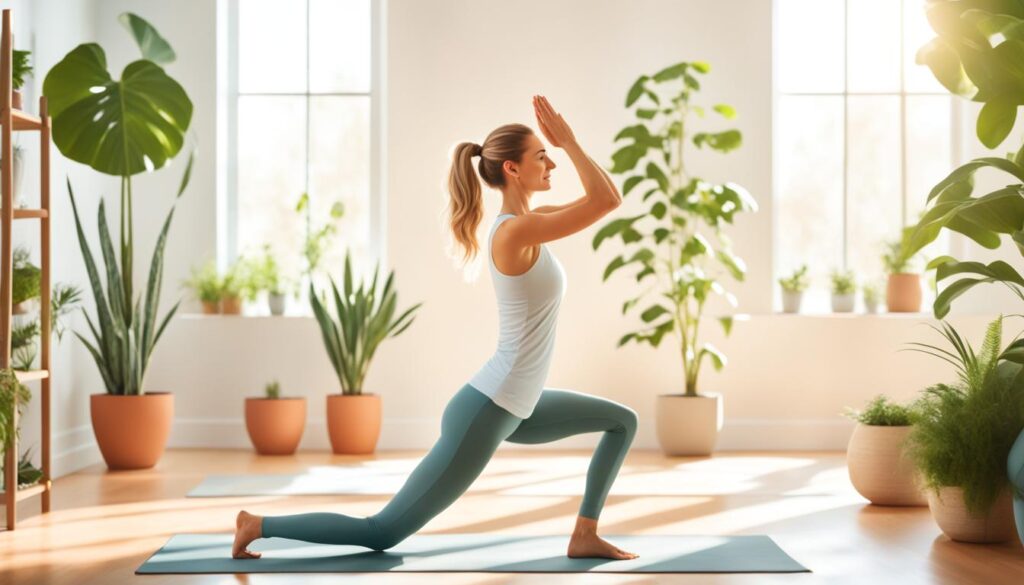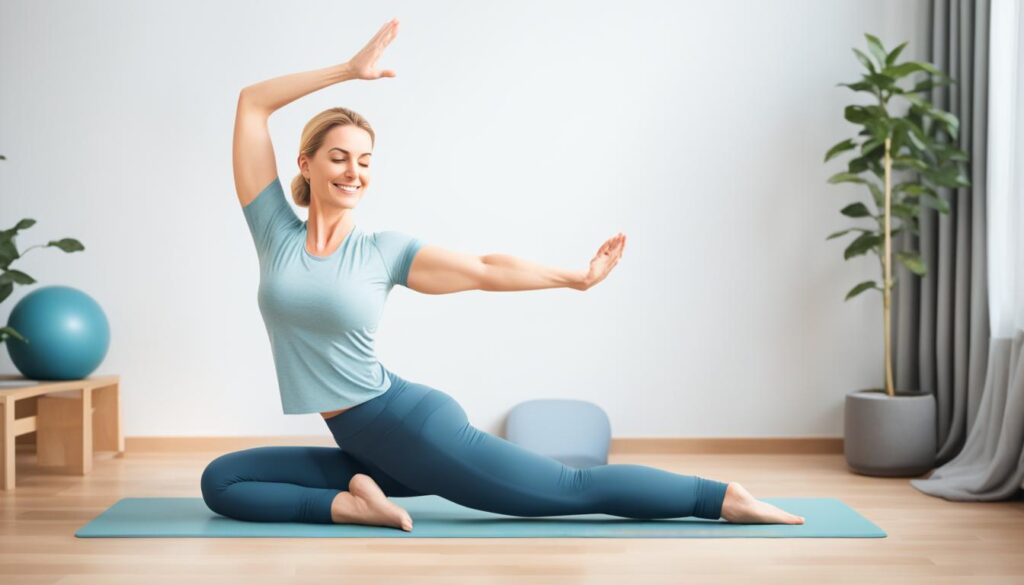Medically reviewed by Dr Chandril Chugh,
Renowned Neurologist and American Trained Specialist
Start your day refreshed with a quick 10-minute yoga flow routine designed to awaken your body and mind. This routine incorporates various poses, including Child’s Pose, Downward-Facing Dog, Rag Doll, Sun Salutation, Low Lunge, Warrior 2, and more. Practicing these poses can help increase energy levels, improve flexibility, and promote a sense of well-being.
Table of Contents
ToggleKey Takeaways:
- Practice a 10-minute yoga flow in the morning to energize your day.
- Include poses like Child’s Pose, Downward-Facing Dog, Sun Salutation, and Warrior 2.
- Yoga can increase energy levels, improve flexibility, and enhance well-being.
- Consistency is key for the benefits of a regular morning yoga routine.
- Always listen to your body and modify poses as needed.
The Benefits of a 10-Minute Morning Yoga Routine
Incorporating a 10-minute yoga routine into your morning can have numerous benefits. Regular practice can boost energy levels, increase flexibility, improve concentration, and enhance the mind-body connection. Additionally, yoga can provide stress relief and create a positive mindset to start the day.

Starting your day with a brief yoga session sets the tone for a positive and productive day ahead. The gentle movements and focused breathing of a morning yoga routine awaken your body and mind, leaving you feeling rejuvenated and ready to face any challenges that come your way.
Increased Energy
Morning yoga promotes increased energy levels by revitalizing your body and releasing tension. The combination of stretching, deep breathing, and mindful movements invigorate your muscles and awaken your senses, providing a natural energy boost without the need for caffeine or stimulants.
Mind-Body Connection
Yoga is a holistic practice that emphasizes the connection between the mind and body. By dedicating a few minutes each morning to yoga, you cultivate a sense of awareness and presence, allowing you to be fully present in the moment. This mind-body connection can foster a greater sense of self-awareness, mindfulness, and overall well-being.
Flexibility and Strength
Regular morning yoga practice helps improve flexibility and build strength. The combination of gentle stretches and targeted poses gradually increases your range of motion and strengthens your muscles over time. As you become more flexible and strong, you’ll notice improved posture and better overall physical performance throughout the day.
Stress Relief and Mental Clarity
The serene and focused nature of a morning yoga routine serves as a powerful tool for stress relief and mental clarity. By incorporating deep breathing techniques and mindful movement, you activate the parasympathetic nervous system, which promotes a state of relaxation and calm. This can help reduce stress, anxiety, and provide mental clarity, allowing you to approach the rest of your day with a clear and focused mind.
By dedicating just 10 minutes each morning to a yoga practice, you can experience these wonderful benefits and set yourself up for a day of increased energy, enhanced mind-body connection, and overall well-being.
Step-by-Step Guide to the 10-Minute Yoga Flow
To practice the 10-minute yoga flow routine, follow these simple steps:
- Start in a comfortable seated position with your legs crossed and your hands resting on your knees. Close your eyes and take a few deep breaths to center yourself.
- Child’s Pose: From the seated position, gently lower your upper body to the floor, bringing your forehead to the mat and extending your arms forward. Take a few breaths here, focusing on deepening your breath and releasing tension in the body.
- Downward-Facing Dog: Press your palms into the mat, tuck your toes, and lift your hips up and back. Create an inverted V-shape with your body, lengthening through the spine and pressing your heels toward the ground. Hold the pose for a few breaths, feeling a stretch through the back of your legs and spine.
- Rag Doll: Slowly walk your feet forward, allowing your upper body to hang freely. Bend your knees as much as needed to release tension in the hamstrings. Grab opposite elbows with your hands and gently sway side to side.
- Sun Salutation: Inhale as you raise your arms overhead, lengthening through the spine. Exhale as you fold forward, bringing your hands to the mat. Step back into a plank position and lower your body to the ground, keeping your elbows close to your sides. Inhale as you lift your chest into Cobra Pose, and exhale as you press back into Downward-Facing Dog.
- Low Lunge: Step your right foot forward between your hands and rise up into a lunge position. Keep your front knee directly above your ankle and reach your arms up overhead. Hold the pose for a few breaths, feeling a stretch through the front of your left hip.
- Warrior 2: Open your hips and arms out to the sides, aligning your front heel with the arch of your back foot. Bend your front knee and gaze over your front hand. Hold the pose for a few breaths, feeling strength and stability in your legs.
- Repeat on the other side: Release the Warrior 2 pose and step your right foot back to meet your left. Repeat the Low Lunge and Warrior 2 poses on the opposite side.
- Corpse Pose: Come down to lie on your back, allowing your body to fully relax. Close your eyes and take a few minutes to rest in this position, allowing the benefits of your practice to settle into your body and mind.
Practice this 10-minute yoga flow routine regularly to experience the physical and mental benefits it offers. The sequence targets different muscle groups, improves flexibility, and helps to release tension, leaving you feeling energized and rejuvenated.
Tips for a Successful Morning Yoga Practice
Establishing a routine is essential for a successful morning yoga practice. By following these tips, you can make the most out of your practice and start your day on a positive note.
- Set a regular practice time: Choose a specific time in the morning that works best for you and stick to it. Consistency is key to establishing a routine.
- Create a tranquil space: Find a peaceful corner in your home where you can practice without distractions. Declutter the area and set up your yoga mat or a comfortable surface for your practice.
- Warm up before starting: Spend a few minutes doing gentle stretches to warm up your body and prepare it for the yoga practice. This can include neck rolls, shoulder stretches, and cat-cow poses.
- Listen to your body: Pay attention to how your body feels and adapt the poses accordingly. It’s essential to honor your body’s limits and avoid pushing yourself too hard.
- Stay hydrated: Drink a glass of water before your practice to stay hydrated and energized. Hydration is crucial for optimal performance.
- Practice deep breathing: Incorporate deep, mindful breaths into your yoga practice. This helps calm the mind, increase focus, and enhance the mind-body connection.
- Start with gentle poses: Begin your practice with gentle poses and gradually progress to more challenging ones. This allows your body to warm up and prevents any strain or injury.
- Take breaks when needed: If you feel fatigued or need a break during your practice, listen to your body and rest. It’s important to avoid pushing yourself beyond your limits.
By implementing these tips, you can establish a successful morning yoga practice that enhances your well-being and sets a positive tone for the day.

Precautions and Considerations
While yoga is generally safe for most people, it’s important to take precautions and consider any physical limitations you may have. Yoga involves various poses and movements that can put strain on different parts of your body. To ensure a safe and enjoyable practice, it is advised to be aware of the following precautions:
- Consult a Doctor: If you have any injuries or medical conditions, it’s advisable to consult with your healthcare provider before starting a yoga practice.
- Listen to Your Body: During your yoga practice, listen to your body and avoid pushing yourself beyond your limits. Respect your body’s signals and avoid any movements or poses that cause pain or discomfort.
- Modify Poses as Needed: Every body is unique, and it’s important to modify poses to suit your individual needs. If you have physical limitations or challenges, make adjustments to the poses to ensure safety and comfort.
By following these precautions, you can ensure a safe and enjoyable yoga practice that brings you closer to your health and wellness goals.

Yoga Precautions in Action
Here are some examples of how to account for your physical limitations and take necessary precautions:
| Physical Limitation | Precautionary Measure |
|---|---|
| Pregnancy | Avoid poses that put pressure on the abdomen and avoid lying flat on your back after the first trimester. Choose prenatal yoga classes or modify poses with the guidance of a certified prenatal yoga instructor. |
| Joint Pain | Modify poses that put pressure on the affected joints. Use props, such as blocks and blankets, to support your body and make the poses more accessible. |
| Back Pain | Avoid deep forward bends and practice gentle backbends under the guidance of a qualified yoga instructor. Incorporate poses that strengthen the core and improve posture. |
Remember, everyone’s body is different, and it’s essential to respect your own limitations. Consult with a yoga instructor or healthcare provider for personalized guidance based on your unique circumstances.
Yoga and Mindfulness in the Morning
Practicing yoga in the morning can be a transformative experience, offering a unique opportunity to cultivate mindfulness and bring awareness to the present moment. By immersing yourself in the practice of yoga, you can enhance your mind-body connection and foster a sense of inner peace and well-being.
Incorporating mindfulness into your morning routine can have profound effects on your overall mental and emotional state. As you flow through different yoga poses, focusing on your breath, body sensations, and movement, you develop a deeper awareness of your body and its capabilities. This heightened awareness translates into greater mindfulness throughout the day, allowing you to navigate challenges with a clear and centered mind.
Benefits of Yoga and Mindfulness in the Morning
Embracing yoga and mindfulness as part of your morning routine offers a multitude of benefits:
- Reduced Stress: By engaging in a mindful yoga practice, you release tension from your body and mind, promoting a sense of calm and relaxation.
- Increased Self-Awareness: Connecting with your breath and body allows you to tune into yourself on a deeper level, fostering self-awareness and understanding.
- Enhanced Focus and Clarity: As you practice yoga and mindfulness, you train your mind to stay present, sharpening your focus and improving cognitive function.
- Promotion of Overall Well-Being: Incorporating yoga and mindfulness into your morning routine sets a positive tone for the day, instilling a sense of balance, contentment, and gratitude.
By making yoga and mindfulness a regular part of your morning routine, you create a solid foundation for a productive and fulfilling day.

Examples of Mindfulness Practices
Here are a few mindfulness practices you can incorporate into your morning yoga routine:
| Mindfulness Practice | Description |
|---|---|
| Body Scan | Bring your attention to different parts of your body, noticing any sensations or areas of tension, and consciously relax those areas. |
| Gratitude Reflection | Take a few moments to reflect on things you are grateful for, cultivating a positive and appreciative mindset. |
| Breath Awareness | Focus on your breath as you move through yoga poses, observing the inhales and exhales without judgment. |
| Mindful Eating | Practice mindful eating by savoring each bite, paying attention to the flavors, textures, and sensations of the food. |
By incorporating these mindfulness practices into your morning yoga routine, you’ll deepen your experience and enhance the overall benefits of your practice.
Start your day with intention and mindfulness by embracing a morning yoga routine that nourishes your body, mind, and soul. By dedicating just a few minutes each morning to cultivate mindfulness through yoga, you set the stage for a day of peace, clarity, and well-being.
Additional Morning Yoga Poses to Explore
In addition to the 10-minute yoga flow routine, you can incorporate several other morning yoga poses into your practice to further enhance your physical and mental well-being. These poses can target specific areas of the body, promote flexibility, and help you start your day with a sense of calm and clarity.
1. Extended Triangle Pose
The Extended Triangle Pose is an excellent way to stretch your hamstrings, open your hips, and strengthen your legs. To practice this pose, follow these steps:
- Start in a wide-legged stance with your feet about 3 to 4 feet apart.
- Turn your right foot outwards and your left foot slightly inwards.
- Extend your arms out to the sides at shoulder height.
- Reach your right hand towards your right foot while keeping your left hand lifted upwards. Rest your right hand on your shin, ankle, or the floor.
- Gently gaze towards your left hand.
- Hold the pose for several breaths, then switch sides.
2. Camel Pose
The Camel Pose is a heart-opening pose that can help improve posture and relieve tension in the chest and shoulders. Follow these steps to practice the Camel Pose:
- Kneel on the floor with your knees hip-width apart.
- Place your hands on the back of your pelvis, fingers pointing downward.
- Inhale and press your hips forward.
- Arch your back and lean back, maintaining a lengthened spine.
- Reach your hands towards your heels or rest your hands on the back of your thighs.
- Hold the pose for several breaths, then come back to an upright position.
3. Seated Forward Bend
The Seated Forward Bend is a calming pose that stretches the entire back of your body, including the hamstrings and lower back. Here’s how to practice it correctly:
- Sit on the floor with your legs extended in front of you.
- Lengthen your spine, sitting up tall.
- Inhale and reach your arms overhead.
- Exhale and fold forward from your hips, reaching for your feet or ankles.
- Keep your spine long and avoid rounding your back.
- Hold the pose for several breaths, then slowly come back up to a seated position.
To help you visually understand these additional morning yoga poses, here is a table summarizing each pose:
| Yoga Pose | Description |
|---|---|
| Extended Triangle Pose | Stretches hamstrings, opens hips, strengthens legs |
| Camel Pose | Opens the chest, improves posture, relieves tension in shoulders |
| Seated Forward Bend | Calms the mind, stretches hamstrings and lower back |
Remember, it’s important to listen to your body and modify these poses as needed. If you experience any discomfort or pain, stop the pose and consult with a qualified yoga instructor or healthcare professional. Incorporating these additional morning yoga poses into your practice can help you explore different movements and deepen your yoga journey.
Integrating Yoga into Your Daily Life
To experience the full benefits of yoga, consistency is key. By incorporating a daily yoga practice into your routine, even if it’s just for a few minutes, you can cultivate a healthier mind-body connection and enhance your overall well-being.
Consistency is the key to reaping the rewards of a regular yoga practice. Whether you choose to practice in the morning or find another time that suits you best, committing to a daily yoga routine can have a profound impact on your physical and mental health.
By making daily yoga a priority, you create space in your life to focus on your body, mind, and spirit. This consistent practice allows you to build strength, increase flexibility, and improve your mental clarity.
It’s important to remember that yoga is not just about the physical poses; it’s a holistic practice that encompasses movement, breathwork, and mindfulness. Incorporating yoga into your daily life means embracing all aspects of the practice and giving yourself the time and space to nourish your mind, body, and soul.
Even a few minutes of yoga each day can make a significant difference in your overall well-being. Consistency is more important than the duration of your practice. Whether you choose to flow through a full sequence or spend a few minutes practicing gentle stretches and deep breathing, the key is to make it a daily habit.
By integrating yoga into your daily life, you create a pathway to optimal mind-body wellness. Embrace the opportunity to connect with yourself on a deeper level and experience the transformative power of a consistent yoga practice.
The Benefits of Daily Yoga Practice
- Improved physical strength and flexibility
- Enhanced mental clarity and focus
- Reduced stress and anxiety
- Increased self-awareness and mindfulness
- Improved overall well-being and vitality
Finding Your Personalized Morning Yoga Routine
Every individual is unique, and finding a personalized morning yoga routine that suits you is important. Explore different poses, flows, and durations to discover what resonates with your body and mind. Pay attention to how different poses make you feel and adjust your routine accordingly. Your personalized morning yoga routine should be something that brings you joy, nourishes your body, and sets a positive tone for your day.
When it comes to creating your personalized morning yoga routine, self-exploration is key. Take the time to try out different poses and sequences, experimenting with what feels best for your body and energizes you in the morning. Be open to exploring new styles of yoga and incorporating elements of mindfulness or meditation if they resonate with you.
To begin your journey of self-exploration, consider incorporating the following steps:
- Start with a few basic poses: Begin your practice with simple poses like Mountain Pose (Tadasana) or Easy Pose (Sukhasana) to ground yourself and connect with your breath.
- Experiment with different sequences: Try out different sequences of poses, such as a gentle flow or a more energetic vinyasa sequence, to see what energizes you the most in the morning.
- Listen to your body: Pay attention to how different poses make you feel physically and mentally. If a pose feels uncomfortable or doesn’t resonate with you, feel free to modify or substitute it with another pose that better suits your needs.
- Adjust the duration: Your morning routine doesn’t have to be long. It can be as short as 10 minutes or as long as you’d like. Listen to your body and find the duration that allows you to feel refreshed and ready for the day ahead.
Remember, your personalized morning yoga routine is all about finding what works best for you. It’s an opportunity to connect with yourself, cultivate self-care, and set a positive intention for the day. Be patient with yourself as you explore different poses and sequences, and enjoy the journey of discovering a routine that nourishes your body, mind, and soul.
Conclusion
Incorporating a 10-minute morning yoga routine into your daily schedule can have a profound impact on your health and overall well-being. By dedicating just a few minutes each morning to connect with your body, breath, and mind, you can cultivate a sense of balance, energy, and mindfulness that will set a positive tone for the rest of your day.
Starting your morning with a gentle flow of yoga poses can help increase your energy levels, improve your focus, and promote a positive mindset. As you explore different poses, flows, and mindfulness practices, you can customize your routine to meet your individual needs and preferences. The key is to find what feels good for you and create a personalized morning yoga routine that enhances your overall quality of life.
Along with the physical benefits, a morning yoga practice can also support your mental and emotional well-being. By bringing attention to your breath and body sensations, you can cultivate a greater sense of self-awareness and mindfulness throughout the day. This can help reduce stress, enhance your ability to cope with challenges, and promote a sense of inner peace and tranquility.
Remember, consistency is key. Establishing a daily morning yoga practice, even if it’s just for a few minutes, can make a significant difference in your overall health and wellness. So, embrace the power of a 10-minute morning yoga routine and experience the transformative effects it can have on your mind, body, and spirit.
FAQ
Can I do the 10-minute yoga flow routine in the evening instead of the morning?
Absolutely! While practicing yoga in the morning has its benefits, you can still experience the positive effects of the 10-minute flow routine at any time of the day.
Do I need any special equipment to do the morning yoga routine?
No, you don’t. The 10-minute flow routine can be done comfortably on a yoga mat, but if you don’t have one, you can use a non-slip surface like a carpet or a towel.
How often should I practice the 10-minute yoga flow routine?
Ideally, it’s good to practice the routine daily to maximize its benefits. However, if you’re short on time, even a few times a week can still be beneficial.
Can I modify the poses if I’m a beginner or have physical limitations?
Absolutely! It’s important to listen to your body and modify poses as needed. If you’re a beginner or have any physical limitations, feel free to adapt the poses to suit your comfort level and avoid any strain or discomfort.
How long should I hold each pose in the 10-minute yoga flow routine?
In the 10-minute flow routine, aim to hold each pose for about 5-10 breaths. However, you can adjust the duration based on your comfort level and the flow of your breath.
Can I add or remove poses from the 10-minute yoga flow routine?
Absolutely! The suggested poses in the routine are a starting point. Feel free to experiment with different poses and create a flow that resonates with you. You can add or remove poses based on your preferences and needs.
Can practicing yoga in the morning help me sleep better at night?
Yes, it can. By practicing yoga in the morning, you can release any built-up tension or stress from the previous day, which can contribute to a calmer mind and better sleep at night.
How long should I wait after eating before practicing the morning yoga routine?
It’s generally recommended to wait at least 1-2 hours after a heavy meal before practicing yoga. However, if you’ve had a light snack, you can proceed with the routine after 30 minutes to an hour.
Can I do the 10-minute yoga flow routine if I’m pregnant?
If you’re pregnant, it’s important to first consult your healthcare provider before starting or continuing any exercise routine. They can provide personalized guidance and recommend pregnancy-safe modifications or specific prenatal yoga routines.
Can I practice the 10-minute yoga flow routine if I have an injury?
If you have an injury, it’s advisable to consult with your healthcare provider or a qualified yoga instructor before practicing the flow routine. They can guide you on modifications or alternative poses to avoid aggravating the injury and support your healing process.
